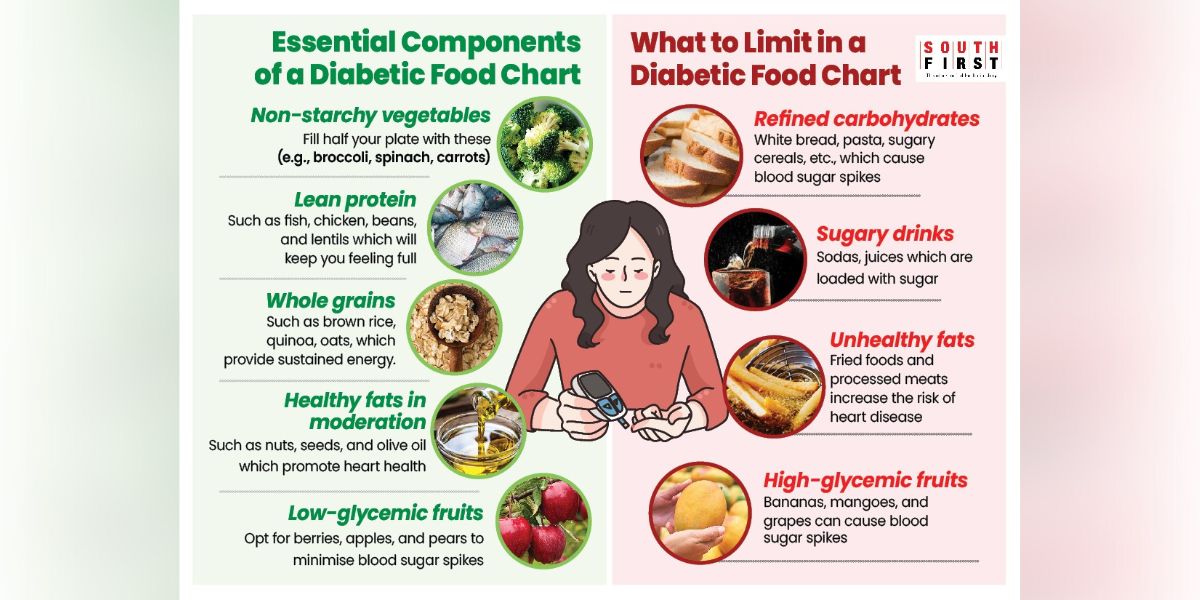Indian diabetic-friendly diet charts can be broadly categorised into vegetarian, non-vegetarian, and low-carb high-fat options.
Published Jul 03, 2024 | 7:00 AM ⚊ Updated Jul 03, 2024 | 5:37 PM

Diabetic diet chart.
A diabetic diet chart is essential for people diagnosed with diabetes to keep the level under control, however, the difference in food choices among Indians makes it difficult to have a common-for-all plan.
Indian diabetic-friendly diet charts can be broadly categorised into vegetarian, non-vegetarian, and low-carb high-fat options, and it’s crucial to consult doctors for personalised advice.
“Diabetes management is no longer a one-size-fits-all approach,” said Dr KN Manohar, an endocrinologist at Manipal Hospital.
“It requires a personalised prescription-based approach. The first and foremost component of this prescription is a well-balanced diet. For this a diabetic food chart also needs to be personalised,” he added.
To delve deeper into this, South First spoke with several endocrinologists to understand how to design a diabetic-friendly food chart.
This article guides crafting diabetic plates, with suggestions from leading endocrinologists.
Dr Srinivasa P Munigoti, Consultant-Endocrinology at Fortis Hospital based in Bengaluru emphasised, “A well-constructed diabetic friendly plate ensures a balanced intake of non-starchy vegetables, whole grains, lean protein, healthy fats and low glycemic index fruits. This helps in preventing spikes in blood sugar levels.”
A standard diet chart for diabetic patients must include:
Non-starchy vegetables: Fill half your plate with these (eg: broccoli, spinach, carrots etc)
Lean protein: Such as fish, chicken, beans, and lentils which will keep you feeling full.
Whole grains: Such as brown rice, quinoa, oats, which provide sustained energy
Healthy fats in moderation: Such as nuts, seeds, and olive oil which promotes heart health.
Low-glycemic fruits: Opt for berries, apples, and pears, to minimise blood sugar spikes.
Refined carbohydrates: Whitebread, pasta, sugary cereals etc., which cause blood sugar spikes.
Sugary drinks: Sodas, juices which are loaded with sugar
Unhealthy fats: Fried foods and processed meats increase the risk of heart disease.
High-glycemic fruits: Bananas, mangoes, and grapes can cause blood sugar spikes.
Keeping the Glycemic Index low is the key to a diabetic diet chart
Dr Shivaprasad C, Consultant Endocrinology at Kinder Hosptials in Bengaluru said a diabetic patient should be extremely conscious of the glycemic index of the diabetic diet.
Glycemic index (GI) is the measure of how soon a food could make blood sugar (glucose) rise.
“Food items that contain only carbohydrates have a high GI. The higher the number, the more it could increase blood sugar. Food items with a number between 1 and 55 are considered low GI, from 56-59, foods are medium GI and high GI is 70 or higher,” he said.
Food items with low Glycemic Index (GI)
Whole wheat, oats meals, soya, low-fat skimmed milk, eggs, brown rice, basmati rice and multigrain bread are recommended by Dr Shivaprasad.
He said fruits like apples, guava, berries, grapes and plums could be consumed.
Vegetables like beans, cabbage, carrot, onions and broccoli also are low in GI.
Avoid red meat and shellfish as they are contributing factors for diabetes, he added.
Sample diet for diabetic patient in a day
Doctors claim that a diabetic can have:
Diabetic patients should not fast or feast, said Dr Shivaprasad adding that they should eat fibrous food and drink plenty of water.
Cooking methods for a diabetic-friendly diet:
Sample vegetarian diet chart for diabetic patients
Breakfast:
Lunch:
Snack:
Chana Chaat: Boiled chickpeas mixed with chopped onions, tomatoes, cucumber, and cilantro, sprinkled with chaat masala.
Dinner:
Dr Abhay Gundubati, an endocrinologist from Bengaluru, advised, “Vegetarian diets can be rich in fibre and antioxidants. The key is to choose whole grains over refined ones and include plenty of non-starchy vegetables to maintain blood sugar levels,”
Sample diet chart for diabetic non-vegetarians
Breakfast:
Lunch:
Snack:
Handful of almonds and walnuts.
Dinner:
Nutritionist Reema N from Bengaluru, highlighted, “Non-vegetarian options should focus on lean proteins like chicken and fish, which are low in saturated fat and provide essential nutrients. Pairing these with high-fibre vegetables ensures a balanced meal.”
Low-carb High Fat (LCHF) diabetic food chart
While several endocrinologists advise a low carb for diabetics diet these days, South First spoke to Shashikant Iyengar, a renowned metabolic health coach who advocates a “Low Carb High Fat” diet for the management of all metabolic health diseases and suggested this simple diabetic plate menu for Indians:
Breakfast
Lunch
Dinner
(Edited by Muhammed Fazil)
(South First is now on WhatsApp and Telegram)
